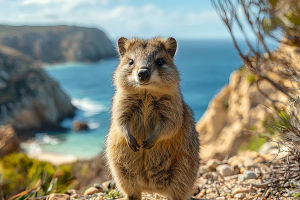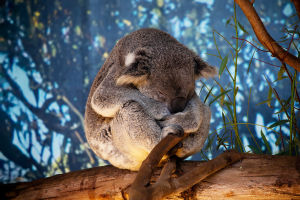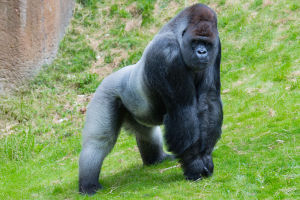When we think of animals that radiate happiness, quokkas immediately come to mind. These tiny marsupials live mainly on Rottnest Island near Perth, Australia, and a few surrounding coastal areas.
From the moment we step onto the island, we notice their playful energy and friendly curiosity.
They hop around with incredible agility, exploring shrubs, grasslands, and rocky paths. Being in their presence feels like entering a world where joy is contagious.
What Makes a Quokka?
Quokkas are small kangaroo relatives, measuring about 40–54 cm from head to tail, with tails around 25–35 cm long. They weigh between 2–5 kg, with males slightly larger at 3.5 kg and females around 2.8 kg. Their rounded ears, short snouts, and soft brownish-gray fur make them instantly adorable. Strong hind legs allow them to jump far and quickly, while their lighter-colored bellies give a gentle contrast to their darker backs. Simply watching them move is a delight for anyone visiting.
The Famous Quokka Smile
One of the reasons quokkas are so beloved is their seemingly permanent smile. Their small, round faces and high-set eyes give them a cheerful appearance, and when relaxed, their facial muscles curve upward, creating an almost magical expression. While they're not literally smiling, we instinctively read it as happiness. Many of us travel to Rottnest Island just to take selfies with them and share that infectious cheer online.
Where They Live and Roam
Quokkas prefer dense shrubs, grassy patches, dunes, and rocky terrain. They usually stay near water sources, which offer both hydration and abundant vegetation. During the day, we can spot them resting in the shade, and early mornings or late afternoons are perfect for observing their active foraging. They also use small burrows or rock crevices as shelters, and some cleverly build simple nests using leaves or twigs to stay safe and comfortable.
What Quokkas Eat
These little hoppers are herbivores. They feed on grasses, leaves, bark, fruits, and tender shoots. While most of their activity happens around dawn or dusk, we can occasionally catch a glimpse of them nibbling plants during daylight hours. Watching them forage, we notice their curiosity and cautious interactions with their surroundings. Their diet and behavior show how well-adapted they are to the island's unique ecosystem.
Social Life and Communication
Quokkas usually form small family groups led by females, where members share foraging spots and alert each other to danger. Males establish territories and defend them against rivals. They communicate through subtle body language, soft sounds, and scent marking. When threatened, they may crouch, bare their teeth, or make a sudden jump to escape. Observing these behaviors, we see how cooperation, vigilance, and alertness are key to survival in the wild.
Reproduction and Raising Joeys
Quokkas can breed throughout the year. Females typically have one or two joeys per year. After a short pregnancy of around 25 days, the tiny joey enters the mother's pouch for about six months, relying entirely on her milk and care. We can imagine the bond between mother and child as the little joey grows and gradually learns to hop, forage, and interact with the environment before venturing out independently.
Conservation and Protection
Quokkas face threats from introduced predators such as cats, foxes, and ferrets, as well as habitat loss from human development. They are classified as "endangered" by the IUCN. Fortunately, Australian authorities have established wildlife reserves on Rottnest Island and other areas, controlling predators and minimizing human interference. With these efforts, we can still experience seeing quokkas thriving in the wild, jumping and smiling as they have for generations.
Our Quokka Moments
Spending time with quokkas is more than a wildlife experience—it's a joyful lesson in living in the moment. Their tiny smiles, bouncy movements, and friendly curiosity remind us to enjoy simple pleasures. Let's plan a visit to Rottnest Island, watch these little hoppers explore their world, and take home memories full of happiness. We'll leave feeling lighter, more cheerful, and inspired by the world's happiest little marsupials.


